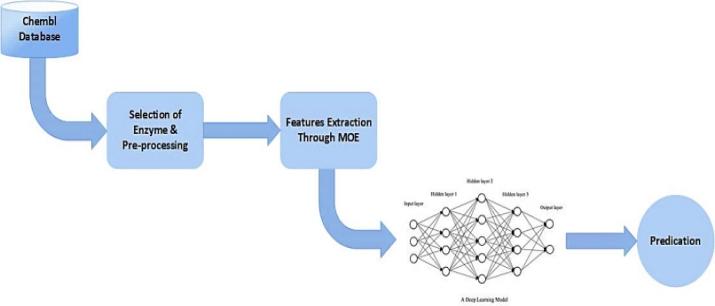Abstract
In the therapy of Coronavirus, the drug target is a demanding task to find novel medicine. A bunch of pharmaceutics procedures are employed to recognize these mutual actions. But they are exhausting and high-priced. Keeping this in view, computational procedures are widely approached to determine the mutual action of the medicine and their respective proteins. Many scientists have applied ML approaches to deduce attributes from simplified molecular-input line systems (for medicine) and protein sequences. Such approaches dropped the proteins' chemical, physical, and structural characteristics and the respective medicine. Our job is to undertake deep learning approaches to detect coronavirus enzyme correspondence with the validated Chembl database medicine. The representation of the molecular structure of proteins, medically known as fingerprints, will be done scientifically. Then, a deep learning model will be given training on the pulled-out fingerprints and the properties of molecules to determine the interplay of the medicine with the respective catalyst. The suggested approach will be proficient in recognizing the catalyst's interactivity with the approved database medicine.
Data Availability Statement
Data will be made available on request.
Funding
This work was supported without any funding.
Conflicts of Interest
The authors declare no conflicts of interest.
Ethical Approval and Consent to Participate
Not applicable.
Cite This Article
APA Style
Khan, T., Hussain, A., Hussain, T., Lin, X., Sharafian, A., Monirul, I.M., & Laila, U. (2025). Prediction of Coronavirus Inhibitors in Drug Discovery through Deep Learning. IECE Transactions on Advanced Computing and Systems, 1(1), 19–31. https://doi.org/10.62762/TACS.2024.974479
Publisher's Note
IECE stays neutral with regard to jurisdictional claims in published maps and institutional affiliations.
Rights and permissions

Copyright © 2025 by the Author(s). Published by Institute of Emerging and Computer Engineers. This article is an open access article distributed under the terms and conditions of the Creative Commons Attribution (CC BY) license (
https://creativecommons.org/licenses/by/4.0/), which permits use, sharing, adaptation, distribution and reproduction in any medium or format, as long as you give appropriate credit to the original author(s) and the source, provide a link to the Creative Commons licence, and indicate if changes were made.


 Submit Manuscript
Edit a Special Issue
Submit Manuscript
Edit a Special Issue

 Copyright © 2025 by the Author(s). Published by Institute of Emerging and Computer Engineers. This article is an open access article distributed under the terms and conditions of the Creative Commons Attribution (CC BY) license (https://creativecommons.org/licenses/by/4.0/), which permits use, sharing, adaptation, distribution and reproduction in any medium or format, as long as you give appropriate credit to the original author(s) and the source, provide a link to the Creative Commons licence, and indicate if changes were made.
Copyright © 2025 by the Author(s). Published by Institute of Emerging and Computer Engineers. This article is an open access article distributed under the terms and conditions of the Creative Commons Attribution (CC BY) license (https://creativecommons.org/licenses/by/4.0/), which permits use, sharing, adaptation, distribution and reproduction in any medium or format, as long as you give appropriate credit to the original author(s) and the source, provide a link to the Creative Commons licence, and indicate if changes were made. 
